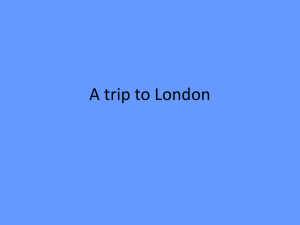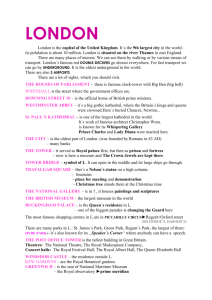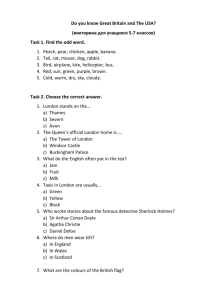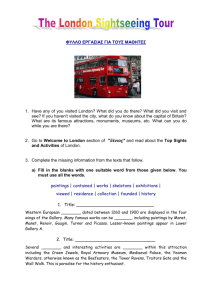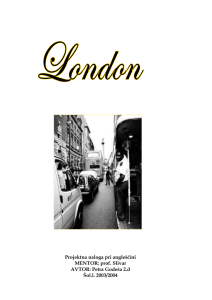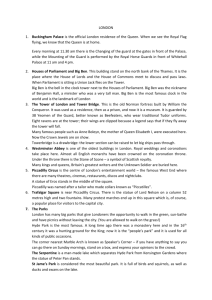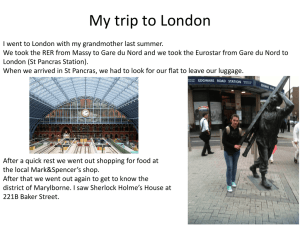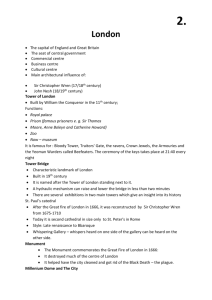england - Gene Gill Travel Guides
advertisement
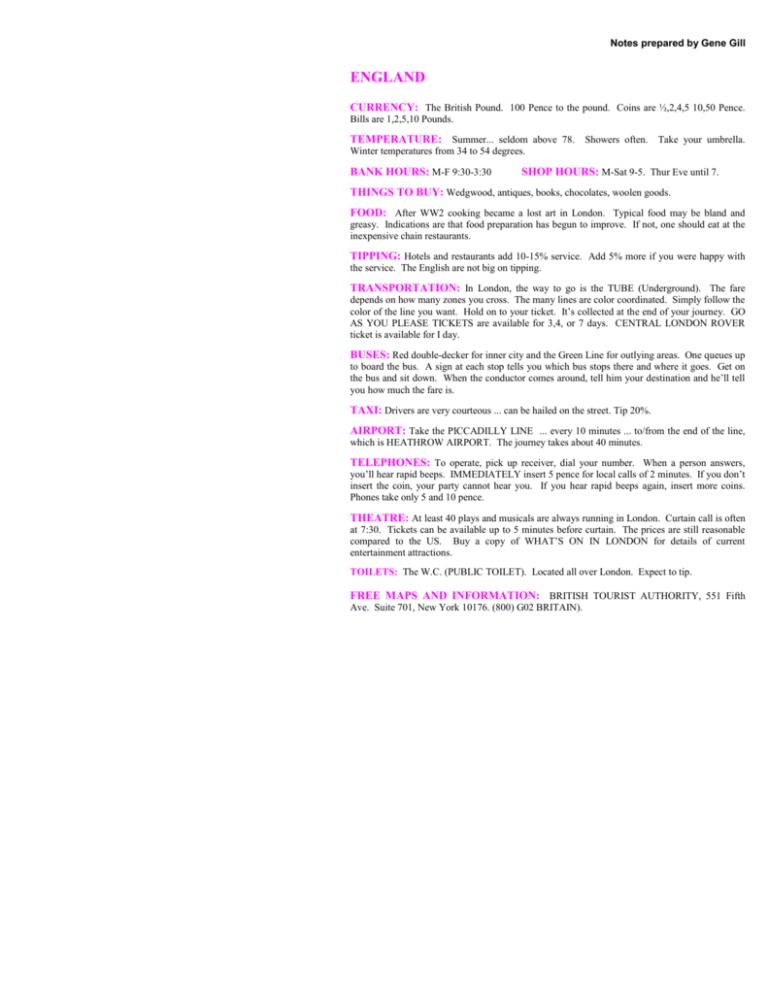
Notes prepared by Gene Gill ENGLAND CURRENCY: The British Pound. 100 Pence to the pound. Coins are ½,2,4,5 10,50 Pence. Bills are 1,2,5,10 Pounds. TEMPERATURE: Summer... seldom above 78. Showers often. Take your umbrella. Winter temperatures from 34 to 54 degrees. BANK HOURS: M-F 9:30-3:30 SHOP HOURS: M-Sat 9-5. Thur Eve until 7. THINGS TO BUY: Wedgwood, antiques, books, chocolates, woolen goods. FOOD: After WW2 cooking became a lost art in London. Typical food may be bland and greasy. Indications are that food preparation has begun to improve. If not, one should eat at the inexpensive chain restaurants. TIPPING: Hotels and restaurants add 10-15% service. Add 5% more if you were happy with the service. The English are not big on tipping. TRANSPORTATION: In London, the way to go is the TUBE (Underground). The fare depends on how many zones you cross. The many lines are color coordinated. Simply follow the color of the line you want. Hold on to your ticket. It’s collected at the end of your journey. GO AS YOU PLEASE TICKETS are available for 3,4, or 7 days. CENTRAL LONDON ROVER ticket is available for I day. BUSES: Red double-decker for inner city and the Green Line for outlying areas. One queues up to board the bus. A sign at each stop tells you which bus stops there and where it goes. Get on the bus and sit down. When the conductor comes around, tell him your destination and he’ll tell you how much the fare is. TAXI: Drivers are very courteous ... can be hailed on the street. Tip 20%. AIRPORT: Take the PICCADILLY LINE ... every 10 minutes ... to/from the end of the line, which is HEATHROW AIRPORT. The journey takes about 40 minutes. TELEPHONES: To operate, pick up receiver, dial your number. When a person answers, you’ll hear rapid beeps. IMMEDIATELY insert 5 pence for local calls of 2 minutes. If you don’t insert the coin, your party cannot hear you. If you hear rapid beeps again, insert more coins. Phones take only 5 and 10 pence. THEATRE: At least 40 plays and musicals are always running in London. Curtain call is often at 7:30. Tickets can be available up to 5 minutes before curtain. The prices are still reasonable compared to the US. Buy a copy of WHAT’S ON IN LONDON for details of current entertainment attractions. TOILETS: The W.C. (PUBLIC TOILET). Located all over London. Expect to tip. FREE MAPS AND INFORMATION: BRITISH TOURIST AUTHORITY, 551 Fifth Ave. Suite 701, New York 10176. (800) G02 BRITAIN). LONDON WESTMINISTER ABBEY: (Tube: Westminster) Open daily 8-7. With its twin towers and early English Gothic design, the Abbey is one of the greatest examples of architecture in the world. It is a shrine to the nation ... the structure in which most rulers were crowned and many are buried...including Britain’s UNKNOWN SOLDIER. The abbey was founded in 1065 by King Edward, the Confessor (his tomb is here) and was completed by William the Conqueror, who was the first and last, foreign invader to be crowned here. Next to Edward’s tomb stands the CORONATION CHAIR with the ancient Scottish relic known as the STONE OF SCONE beneath the chair. The entire Abbey is crammed with treasures. There are some strange waxworks, showing the images of important personalities. These were carried in their funeral processions. There’s a POET’S CORNER with tombs or monuments of poets from Chaucer to Thackery. Most English kings and queens are buried here also. A fee is charged to enter the ROYAL CHAPELS. HOUSES OF PARLIAMENT: Formerly the Royal Palace of Westminster until Henry VIII moved to Whitehall. Today these buildings house the government- the houses of Commons and the Houses of Lords. Parliament frequently doubled as a courthouse. Sir Thomas More and King Charles I were tried and sentenced to death here. The 320-foot tower that houses BIG BEN was undamaged during WW2 and continued to strike its chimes. Big Ben was named for Sir Benjamin Hall, a cabinet minister distinguished only by his long-windedness. Be sure and walk to the middle of WESTMINSTER BRIDGE to see Parliament reflected on the Thames...and also walk around to the back for a lovely park and views of the Thames. NUMBER 10 DOWNING STREET: (Tube: Westminster). Walk toward Trafalgar Square along Whitehall, which is the street of British Government ... make a short detour to your left, near the CENOTAPH. You’ll see #10 ... a modest 3-story brick building which serves as the official residence for the Prime Minister. The street is no longer open to the public but you’ll be able to see it from the barricade. TOWER OF LONDON: (Tube: Tower Hill). Mon-Sat 9:30-5. Sun 2-5. This tower was formerly used as a residence and coronation site for royalty, but is noted mainly as a prison and place of execution. THE WHITE TOWER, begun in 1078 by William the Conqueror, is the oldest building in London. After James 1, the tower became a prison. Two of Henry VIII’s wives, Anne Bolyne and Catherine Howard lost their heads here. The first Elizabeth spent one night here before she became queen. not knowing whether or not she would leave alive. Sir Walter Raleigh spent 13 years here before his execution. On the walls of BEAUCHAMP TOWER you can actually read the last messages scratched by despairing prisoners. In the JEWEL HOUSE lie England’s CROWN JEWELS, some of the most precious stones known. They are worn by each monarch at his/her coronation and then returned to this vault where they are heavily guarded. The famous BEEFEATERS take tour-groups through the grounds, or you can go on your own. EXPECT LONG LINES and CROWDS. LONDON ... continued TOWER BRIDGE: One of London’s most famous landmarks. Despite its medieval appearance it was built in 1894 and is something of an engineering marvel. The main traffic deck consists of two giant spans, which are hinged and can be hoisted up to allow ships to go by. Take the elevator to the top of one of the towers for spectacular views. The best view of the Tower Bridge is from The Tower of London. ST PAUL’S CATHEDRAL: (Tube: St.Pauls). Daily 8-7. London’s largest and most beautiful church. Built by Sir Christopher Wren on the spot of the Cathedral, which burned in the fire of 1666, St. Paul’s represents his masterpiece. The golden cross surmounting it is 365 feet above ground. The golden ball on which it rests is 6 feet in diameter. Surrounding the interior of the dome is the WHISPERING GALLERY an acoustical marvel where the faintest whisper can be heard on the opposite side. Buried here are the Duke of Wellington and Sir Christopher Wren. Prince Charles and Princess Diana were married here. BUCHINGHAM PALACE: In St. James Park, this is the official residence of the Queen. The palace was built originally as a red brick country house for the Duke of Buckingham in 1703. In 1762 it was purchased by George III who needed room for his 15 children. He expanded the building and faced it with Portland Stone. Bombed twice in WW2, the palace today, stands 360 feet long in a 40-acre garden and contains 600 rooms. Every summer morning at 11:30 ,THE CHANGING OF THE GUARD takes place. The ceremony lasts 1 ½ hour and is a fine example of military pageantry. The new guard, marching behind a band, comes from their barracks and takes over from the old guard in the forecourt of the palace. These guards date back to 1642. The best viewing point in across from the palace around the square of the VICTORIA MOUMENT. Victoria was the first resident, and the palace has been the official residence of royalty since 1837. TRAFALGAR SQUARE: (Tube: Charing Cross) A famous square in the heart of London with a statue of Wellington in the center on top of a column. The National Gallery is on this square. NATIONAL GALLERY: (Tube: Charing Cross) Mon-Sat 10-6. Sun 2-6. Free. This neoclassical building contains a marvelous collection of paintings covering every great Art Movement for 7 centuries (all but the 20th century). Outstanding are the Rembrandt’s (Two selfportraits), a gallery of Rubens, da Vinci’s VIRGIN OF THE ROCKS, and works by Titian, Bellini, Van Eyck, Botticelli, Michelangelo, El Greco, Velasquez, Vermeer, Degas, Renoir, Cezanne, and Monet. At the entrance to the museum is a statue of George Washington. NATIONAL PORTRAIT GALLERY: Behind the national Gallery on St. Martin’s Place. Daily 10-5. Sun 2-6. An interesting short stop to see who was who. There are paintings of everyone from the 15th century on. Exceptional works by Holbein, Gains borough, and Reynolds. LONDON…continued THE BRITISH MUSEUM: (Tube: Russell Sq or Tottenham Ct Rd) On Great Russell Street. Daily 10-5. Sun 2:30-6. Free. This immense museum alone is well worth the trip to London. It grew out of a private collection of manuscripts in 1753. Today it is one of the largest museums in the world and contains millions of objects. Do see the EGYPTIAN ROOMS, which contain the famous ROSETTA STONE, which led to the deciphering of hieroglyphics. See the DUVEEN GALLERY which houses the ELGIN MARBLES, a priceless series of marble sculpture that Lord Elgin helped himself to. They were the FRIEZE from Athens’s PARTHENON. The Assyrian Transept has the legendary BLACK OBELISK dating from 860 BC. You’ll also see Egyptian mummies, 2000-year-old costumes, weapons, tools, historical papers (including the original MAGNA CARTA), and papers signed by everyone related to England’s history. COURTAULD INSTITUTE GALLERY: (Tube: Temple) Located within Somerset House off the Strand. Daily 10-5. Sun 2-5. Masterpieces by Monet, Manet, Degas, Renoir, Cezanne (8), Van Gogh, and Gauguin, plus a collection of old master drawings. This museum is now in new quarters. The paintings are well worth the effort it takes to find the museum. WALLACE COLLECTION: (Tube: Bond St. or Baker St). Daily 10-5, Sun 2-5. Free. Located on Manchester Square. Gathered in a palatial setting is an array of French artists ... Watteau, Boucher, Fragonard, as well as Halls famous LAUGHING CAVALIER, and a great Rembrandt SELF PORTRAIT. Interesting building and collection. Doesn’t take long. HYDE PARK AND THE MALL: (Tube: Marble Arch and others) One of the largest parks in the world, covering 636 acres. At the southern tip, near MARBLE ARCH is THE SPEAKER’S CORNER, where anyone can get up and talk about anything in the world. Hyde Park was once the hunting grounds for Henry VIII. A beautiful lake...horse trails ... people! ALBERT MEMORIAL: (Tube: So Kensignton) A rather over-done memorial built by Victoria to honor her beloved Albert. In Hyde Park across from ALBERT HALL, where concerts are held. VICTORIA AND ALBERT MUSEUM: (Tube: So Kensignton) Open daily 10-5. Sun 25. Free but a donation is requested. Named after the queen and her consort, this very lively museum is devoted mainly to the decorative arts ... galleries of clocks... costumes ... decorative metal works ... jewelry ... etc. But there are also the CARTOONS by Raphael ... a room devoted to his very large designs, which became tapestries. Interesting Museum with a very nice tea room/restaurant.. KENSINGTON PALACE: (Tube Queensway or High St Kensington) ... Walk from Hyde Park or from Kensington Gardens. Daily Mon-Sat 9-5. Sun 1-5. See the STATE APARTMENTS, which were used by Queen Victoria (and where she was born), and especially the room housing gifts presented to her... also a very interesting wing devoted to costumes. Prince Charles and Diana lived in a separate wing of Kensington until their divorce. Diana continued to live here until her death. This palace became the main pilgrimage-spot prior to her funeral. LONDON ... continued HARROD’S DEPARTMENT STORE: (Tube: Knightsbridge) On Brompton Road, Knightsbridge. This is a famous sightseeing attraction. merchandising is dazzling. Have a look. The sheer range and variety of MADAM TUSSAUD’S WAX MUSEUM: (Tube: Baker Street). Daily 10-6:30. Madam Tussaud learned her art in France...attended the court of Versailles and personally took the death masks from the guillotined heads of Louis XVI and Marie Antoinette. The masks are on display here. She moved her museum to London in 1802. Here are displayed a legion of famouspersonalities. The best-known portion is the CHAMBER OF HORRORS, which contains many authentic “props” for famous murders. There’s also a PLANETARIUM SHOW and the BATTLE OF TRAFALGAR. TATE GALLERY: (Tube: Pimlico) Daily Mon-Sat 10-6. Sun 2-6. Free. This museum houses the National collection of British art from the 16th century to the present ... plus an international array of moderns, including Picasso, Braque, Dali, Chagall. But, one usually goes here to study TURNER and BLAKE in depth. The largest Turner collection anywhere. TATE MODERN: (Tube: Blackfriars…walk across bridge to Bankside) Daily Mon-Sat 106. Sun 2-6. Free. The new Tate Modern, housed in the former Bankside Power Station, opened in 2002 to great critical acclaim. Collection from 1900: Picasso up to the present. COVENT GARDEN: (Tube:Covent Gard) This is England’s historic market place, and St. Paul’s Covent Garden, a small church, is the opening setting for G.B.Shaw’s PYGMALION (My Fair Lady). Today, the Garden has been re-done, and contains many shops. PICCADILLY CIRCUS: (Tube: Piccadilly) A large square which typifies “swinging London”. Lots of neon and fancy signs. SIR JOHN SLOANE’S MUSEUM: (Tube: Chancery Lane or Holborn) ... at 13 Lincoln in Fields. Tue-Sat 10-5. Former home of man who rebuilt the Bank of England. See Hogarth’s famous series of paintings THE RAKE’S PROGRESS. WELLINGTON MUSEUM (Apsley House): (Tube: Hyde Park Corner) ... at #149 Piccadilly. Tu/W/Th/Sat 10-6, Sun 2:30-6. The former home of the Duke of Wellington. See Canova’s STATUE OF NAPOLEON, 3 fine Velasquez’s, and Correggio’s AGONY IN THE GARDEN. Wellington Arch is nearby and is now open to the public. MUSEUM OF LONDON: (Tube: St. Paul’s) ... at #150 London Wall. This museum traces the history of London from pre-history to the present. LONDON DUNGEON: (Tube: London Bridge) Located under the arches of London Bridge Station... simulates an atmosphere to chill the blood. The museum faithfully reproduces the conditions of the Middle Ages with a series of tableaux, depicting life in Old London. The rumble of trains overhead, and tolling bells adds to the horror. Daily 10-6. IMPERIAL WAR MUSEUM: On Lambeth Rd. (Tube: Lambeth No-Elephant & Castle). CABINET WAR ROOMS: (Tube: Westminster) These rooms were used by Churchill from the outbreak of WW2 until the Japanese surrendered in 1945. LONDON ... continued ROYAL ACADEMY OF ARTS: (Tube: Piccadilly or Green Park). Major exhibitions throughout the year. Daily 10-18. THE SAATCHI COLLECTION: (On Kings Road. Nearest Tube: Sloan Sq and 4 minute walk). An outstanding private collection of MODERN ART. Very few people know about this museum. The Saatchi Gallery aims to provide an innovative forum for contemporary art, presenting work by largely unseen young artists or by international artists whose work has been rarely or never exhibited in the UK. The Gallery has recently opened in the 70,000 sq. ft. Duke of York HQ building on King's Road, Chelsea LONDON ZOO: (Tube: Baker Street or Camden Tower) ... and then bus #74 ... or walk. Open daily 9-dusk. One of the greatest zoo’s in the world... 2 pandas. There are also canals around the zoo... similar to Amsterdam ... where you can travel via boat. ADDRESSES OF SOME FAMOUS LONDONERS: Look for a plaque on the side of the building. Charles Dickens…………… #48 Doughty St. WC1 . Tube: Russel Square. Dr. Johnson #17…………… Gough Square. Tube: Blackfriars. M-Sa 11-5:30 John Keats Keats……………Grove, NW3. Tube: Belsize Park. William Blake………………#74 Broadwick Street, Soho. Benjamin Franklin ………….#36 Craven St. WC2 Thos. Gainsborough…………#82 Pall Mall SWl Florence Nightingale………. #10 South Street NWl Elizabeth B. Browning ……..#50 Wimpole St. WI Rudyard Kipling…………….#43 Villiers St. WC2 Isaac Newton………………. #87 Jermyn Street WI “Sherlock Holmes”…………. #22 1b Baker Street THE LONDON PALLADIUM: (Tube: Oxford Circus) ... on Argyll Street. This famous theatre opened in 1910. It’s the English equivalent of New York's PALACE. KEW GARDENS: (Tube: Kew Gardens) ... Located in Richmond... out of London. Lovely Botanical Gardens ... great place to spend a relaxing few hours. GREENWICH: Take the train from Charring Cross Station ... or more interestingly, take a Thames River Boat from Charring Cross Pier... every 20 minutes. Trip takes 50 minutes. This famous river port is where GREENWICH MEAN TIME is established... also where you'll find the ROYAL NAVAL COLLEGE, the MARITIME MUSEUM, and the famous clipper ship, the CUTTY SARK. THE LONDON EYE: Jubilee Gardens, South Bank. Tube: Waterloo. Every 30 minutes from 9:30. This is the world’s largest observation wheel which soars 450 feet above the river and gives spectacular views of London. CHISWICK HOUSE: Tube: Turnham Green. One of England’s finest Palladian villas. The interiors are lavishly decorated, while outside you’ll find the Italianiate gardens filled with statures, obelisks and a winding road. THE MONUMENT: Tube: Monument. This 202 foot high Doric Column, designed by Christopher Wren, commemorates the Great Fire of London in 1666. It is the tallest isolated stone column in the world and is located near the spot where the fire began. DR. JOHNSON’S HOUSE: Tube: Chancery Lane. Exhibits include a first edition of the dictionary, prints, portraits and furniture. DICKEN’S HOUSE MUSUEM: Tube:Russell Square. Dickens lived here from 1837 to 1839. It was here that he wrote The Pickwick Papers, Oliver Twist, and Nicholas Nickleby. DALI UNIVERSE: Tube: Waterloo. County Hall, Riverside Building. Daily 10-6PM. Dali’s sculptures, drawings, and paintings, furniture, and jewelry. Including “Mae West Lips Sofa”. SIR JOHN SLOANE’S MUSEUM: Tube: Holborn. 13 Lincoln’s Inn Fields. Tue-Sat 105PM. Jewel of a museum containing the collections of architect Sloane. Among its many treasures are paintings by Canaletto, Reynolds, and Turner, rare clocks and furniture, and classical antiquities. LONDON…A WALKING TOUR. Begin the walk on Whitehall, near Big Ben: THE ADMIRALTY: The rambling building on your right ... and the chief office of the governing body of the Royal navy. Here Admiral Nelson lay in state after his death at Trafalgar in 1805. The building is secluded from Whitehall by a charming stone screen designed by Robert Adam in 1760. ADMIRALTY HOUSE ... on the south of the Admiralty ... used for government receptions. HORSE GUARDS...This section of the Admiralty has a picturesque clock tower built in 1742. Two mounted troopers of the Household Cavalry (in resplendent uniforms) are posted here from 10 AM - 4 PM, but they are relieved every hour. At 11 AM, the ceremony of the CHANGING OF THE GUARD is performed... a colorful spectacle lasting about 1 ½ hour. BANQUETING HOUSE...This is the chief surviving part of the Royal Palace WHITEHALL, which was an early and splendid example of Classical architecture, built in 1619, and the first example in England of the style evolved by the Italian architect Palladio. In the 13th century this was known as York House, when it was seized by Henry VIII who enlarged it and changed the name to Whitehall. The old palace originally covered a large area now bisected by Whitehall Street and extended east to the river. For 100 years this was the chief residence of the court of London. Henry VIII was married here to Anne Boleyn in 1533, and died here in 1547. Elizabeth I was taken from the palace to become a prisoner in the Tower, and returned in triumph on her accession as queen. After the building was mostly destroyed in the great fire of 1619, plans for a new palace were drawn up, but only the Banqueting House was completed. From a window in an annex on the north side, Charles I stepped to his execution in 1649. The wellproportioned Banqueting Hall is 110 feet long by 55 feet high, and is especially remarkable for the 9 allegorical ceiling paintings designed for Charles I by Rubens. 10 DOWNlNG STREET...the official residence of the Prime Minister... famous out of proportion to its appearance. It is named after its builder, Sir George Downing. The interior was rebuilt in 1960 but most of the historic features were incorporated. During the demolition of the old building, remains of the original Whitehall Palace were brought to light, including part of the great hall converted by Henry VIII into a tennis court. Samuel Pepys the diarist, lived approximately on this site from 1658 to 1660. CENOTAPH... rising in the center of Whitehall Street, this monument is inscribed …to the Glorious Dead" and commemorates all servicemen of the Empire who gave their lives in the two World Wars. LONDON ... A WALKING TOUR ... continued ST. JAMES PARK... the most attractive park in London ... 93 acres bounded on the north by THE MALL and on the south by Birdcage Walk. It was once a marshy meadow, which was drained by Henry VIII and converted into a deer park adjoining his new palace of Whitehall. The lake was added in 1829. QUEENS GALLERY ... on the south side of Buckingham Palace and through Buckingham Gate. This was formerly the private chapel of the palace, but was converted to show a selection of the best art in the Royal Collection. BUCKINGHAM PALACE ... originally built in 1702 and rebuilt in 1913, this palace has a classical facade 360 feet long. The palace was little used until the accession of Queen Victoria in 1837, after which it became the permanent residence of the Court. The apartments of the royal family are in the north wing. Visiting is not allowed. (Recently the queen opened part of the palace during the months of Sep/Oct…to help pay for rebuilding Windsor). ROYAL MEWS ... where the Queen’s horses are stabled and her coaches are kept. The coaches include the splendid State Carriage from 1762, which is used for all coronations, and the Irish State Coach used in 1852 by Queen Victoria for the Opening of Parliament, and the glass State Coach from 1910, which is used for Royal weddings. VICTORIA MEMORIAL ... completed in 1911 by Sir Thomas Brock. From a platform embellished with marble water basins, rises a pedestal surmounted by a gilt-bronze figure of VICTORY, at whose feet sit COURAGE and C0NSTANCY. At the base, facing the Mall, is the seated figure of Victoria, 13 feet high, carved from a solid block of marble. On the sides of the pedestal are marble groups, which represent TRUTH, MOTHERHOOD, and JUSTICE. Around the memorial are further groups in bronze symbolizing SCIEIICE, ART, PEACE, PROGRESS, NAVAL POWER, INDUSTRY and AGRICULTURE. The small garden surrounding the memorial is enclosed by a balustrade with piers supporting sculpture, which includes the Heraldic Shields of countries in the British Commonwealth. CLARENCE HOUSE ... the home of the Queen Mother until her death in 2002. The interior was restored in 1949 for Princess Elizabeth, who occupied the home until 1952. Princess Anne was born here. ST. JAMES PALACE...a rambling and picturesque brick mansion of Tudor origin built around several courtyards. It was once the official London residence of the Royal Family and the scene of all-important Court Functions. Foreign ambassadors are still accredited to “the Court of St. James”. The name of the palace is derived from a leper hospital dedicated to St. James the Less, which was located here until Henry VIII replaced it with a palace designed by the artist Holbein. The chief relic of this Tudor palace is the picturesque four-story GATEHOUSE or CLOCK TOWER. No public visits to the palace. (Princess Diana’s casket was “held” in the chapel until public outcry caused the monarchy to move it to Kensington Palace). LONDON ... A WALKING TOUR ... continued PICCADILLY CIRCUS... a very colorful square ... on the north is the NEW PICCADILLY HOTEL from 1908 ... on the south is the modern wrought-iron entrance to ST. JAMES CHURCH, designed by Christopher Wren in 1676. The heavy Renaissance-style facade belongs to BURLINGTONHOUSE, and is the headquarters of the ROYAL ACADEMY OF ARTS. An imposing archway opens to the center where there is a statue of the founder of the Academy ... Sir Joshua Reynolds. Special loan exhibitions are often held here. Galleries also contain diploma works presented from artists on their election by Academicians, such as selfportraits by Reynolds and by Gainsborough ... plus many sketchbooks of famous artists, as well as their palettes and painting tables. Here, also, is the MICHELANGELO TONDO, a relief of the VIRGIN AND CHILD, and the only sculpture by Michelangelo in England. The RITZ HOTEL is on the south side of Piccadilly, and was one of the first steel-framed buildings built in London. TRAFALGAR SQUARE...commemorates Nelson’s great naval Victory of 1805. The square was laid out in 1929, partly on the site of the Royal Mews. On the south side rises the NELSON MONUMENT. On the pedestal are four bronze lions by Sir Edwin Landseer. They were cast from cannon recovered from the wreck of the Royal George, which sank in 1782. Additional reliefs, cast from captured French cannon, show scenes from Nelson’s battles. At the corners of Trafalgar are statues of Generals Napier and Havelock. Behind the Nelson monument are two ornamental fountains. Above the northeast corner is an equestrian statue of George IV. A fir tree, the annual gift of the people of Norway in memory of the hospitality shown their Royal Family during WW2, is illuminated here every Christmas. On the north side, across the street is THE NATIONAL GALLERY. The church is ST. MARTIN IN THE FIELDS. LONDON … continued: EXCURSIONS FROM LONDON HAMPTON COURT PALACE: 15 miles from London. Take a frequent train from Waterloo Station to Hampton Court ... or Green Bus #718 from Victoria Station. The trip takes about 40 minutes. Daily 9:30-5. Hampton Court was built by Cardinal Wolsey in 1515 and was taken over by Henry VIII. It is a mammoth Tudor structure and contains THE STATE APARARTMENTS, an indoor kitchen where an entire ox could be roasted, and beautiful gardens with the famous MAZE. Hampton Court is England’s Versailles ... and a highly recommended excursion. WINDSOR CASTLE: 25 miles from London. Take the train from Waterloo or from Paddington Station ... or Green Bus #704, #705 from Victoria Station. Open daily 10:30-5, Sunday 1:30-5. This is the largest inhabited palace in the world and is open to visitors even when the queen is in residence. Windsor has been the country residence of royalty for over 850 years. The charming village of Windsor is a Victorian town with lots of brick buildings. From the station it’s a 5-minute walk to he castle: …contain many works of art, porcelain, armor, and furniture. The KING’S DRAWING ROOM has paintings by Rubens, and in the Dressing Room are a Durer and a Rembrandt. The GRAND RECEPTION ROOM is the most spectacular. STATE APARTMENTS: …held daily at 10:30 except on Sunday. Some think this is more impressive than in London. Here, the guard marches through the town of Windsor, stopping traffic as it moves to the castle to the tune of a full regimental band. When the queen is not in residence, there’s a drum and pipe band. CHANGING OF THE GUARD: OLD MASTER DRAWINGS: …The Royal Family possesses a rare collection at Windsor of drawings by the Old Masters…notably a large collection by da Vinci. Some of the drawings are always on view. 10:30-5. QUEEN MARY’S DOLLHOUSE: …is just about the greatest dollhouse in the world. Presented to the late queen as a gift, it is a remarkable achievement of what a great royal mansion of the 1920’s looked like. Everything is done with exacting detail – even the Champagne bottles in the wine cellar contain vintage wine of the era. There’s a toothbrush suitable for an ant, and a tiny electric iron, which really works. ST. GEORGE’S CHAPEL: …is a gem of the Perpendicular style. It shares with Westminster Abbey the distinction of being a pantheon of English monarchs. The present chapel was founded in the late 15th century. One enters the nave first with its fan vaulting. Here are the tombs of George V and Queen Mary. Off the nave in URSWICH CHAPEL is the Princess Charlotte memorial. In the center is the vault of the beheaded Charles I, along with Henry VIII and Jane Seymore. There’s also a memorial to Prince Albert. 10-4 PM. LONDON…continued: EXCURSIONS FROM LONDON STRATFORD-UPON-AVON: 121 miles and 2 hours by train from Paddington Station. There are many Elizabethan buildings in this colorful town. One ticket will admit you to see the most important sights. All major sights are open from 9-6 PM. Allow yourself time to explore the village because it has a great deal of charm: SHAKESPEAR’S BIRTHPLACE : …on Henley Street. Shakespeare was born here April 23, 1564 and died 52 years later on the same day. The home is filled with memorabilia, including a portrait, and furnishings of the writer’s time. The building is a typical half-timbered structure dating from the early years of the 16th century. See the oakbeamed living room, the bedroom where Shakespeare was born, and the full kitchen. Walk through the garden out back. ANNE HATHAWAY’S COTTAGE: …located 1 mile from Stratford at SHOTTERY…really too far to walk. The thatched, wattle-and-daub cottage is where Anne lived before her marriage to Will. In sheer charm, it is one of the most interesting buildings in the area. The Hathaway’s were farmers and their home provides insight into family life during this period. Much of the furniture and accessories are original. Shakespeare was only 18 when he married the much older Anne. NEW PLACE: …This building, on Chapel Street, is where Shakespeare retired to in 1610. He died here 6 years later. The current house is a reconstruction. The KNOTT GARDEN, which adjoins the house, is worth a visit. MARY ARDEN HOUSE: …where Shakespeare’s mother lived. It’s a half-timbered house 3 miles from Stratford. Mary, too, was from a family of farmers. The barn here is now a museum. HOLY TRINITY CHURCH: This lovely parish church of Stratford is distinguished because Shakespeare is buried in the Chapel. A contribution is requested to see his tomb. HARVARD HOUSE: Home of Katherine Rogers, the mother of John Harvard, who was the founder of Harvard University. It’s a fine example of an Elizabethan town house from 1596. The present furniture is from the original period. AN ELIZABETH SHOW: The New Heritage Theatre continuously presents an Elizabethan pageant, which tries to recreate the time of Shakespeare. The current pageant is an outgrowth of one from 1575. ROYAL SHAKESPEARE THEATRE: This is the famous theatre where Britain’s foremost actors perform during the “season”. LOUIS TUSSAUD’S WAXWORKS: 60 Henley Street. The comedies, tragedies, and histories of all Shakespeare’s plays are illustrated with wax figures. LONDON…continued. EXCURSIONS FROM LONDON BATH: Frequent trains from London Paddington Station…1 ½ hours. In 1702 Queen Anne made the 115-mile trip from London to the Mineral springs of BATH. This launched a fad that was to make the city the most celebrated spas in England. Actually, Bath had two lives. It was built by the early Romans and known as AQUAE SULIS. These early Romans visited the baths to ease their rheumatism. In addition to the major sights here, do notice the buildings, the squares and especially the ROYAL CRESCENT, which is an elegant half-moon row of town houses. ROMAN BATHS AND PUMP ROOM: Founded in AD 75 by the Romans, the baths were dedicated to the goddess Sol Minerva. In their day they were an engineering feat, and still today, are considered among the finest Roman remains in England. They are still fed by the only hot springs in Britain. Visit the excavations, the museum have coffee in the PUMP ROOM. BATH ABBEY: Built on the site of a much larger Norman Cathedral, the abbey is England’s last great medieval church, dating from 1539. It is called ‘LANTERN OF THE WEST’ because of its many windows. ASSEMBLY ROOMS AT BATH: These stately and ornate public rooms were originally designed by John Wood in 1769. Today they house a costume museum featuring 300 years of fashion. THEATRE ROYAL: This prestigious theater was built in the 17th century and continues to sponsor performances throughout the year. JANE AUSTEN CENTRE: A permanent exhibition that tells the story of one of Bath’s most famous residents. ROYAL CRESCENT: Designed by John Wood, the Royal Crescent is comprised of thirty houses, shaped like a half-colosseum, which uses a gigantic series of Ionic columns on high bases. KING’S CIRCUS: Built between 1754-58 by John Wood, this is one of the best examples of classical urban architecture in Britain. It resembles the Colosseum in Rome with its successive tiers of Doric, Ionic and Corinthian columns. PULTENEY BRIDGE: One of the 3 bridges in the world lined with shops, this exquisite 18th century bridge is one of the most admired structures in Bath. Bath…continued SALLY LUNN’S MUSEUM: The home of “Sally Lunn Bun” is the oldest house in Bath, which features a kitchen museum reflecting early English heritage. 4 SYDNEY PLACE: Author Jan Austen lived at this loction for 3 years, where she wrote some of her novels that vividly describe the fashionable life in Bath during the early 19th century. MONTACUTE HOUSE: Built at the end of the 16th century, this is considered one of the most beautiful Elizabethan houses in England. PARAGON ANTIQUES AND BYGONES: Open market specializing in antiques. BARTLETT STREET: An antique lover’s dream…more than 50 dealers. LITTLE SOLSBURY HILL: Believed to be the site of King Arthur’s decisive victory. The hill overlooks scenic Bath. AMERICAN MUSEUM: This museum chronicles the American lifestyle and culture from the New England colonists to the Civil War. MILSOM STREET: Historic street that is lines with charming shops and restaurants. HOLBURNE MUSEUM OF ART: Offering an impressive collection of fine arts. LONDON…continued. EXCURSIONS FROM LONDON SALISBURY -STONEHENGE Frequent trains from London’s Waterloo Station…1 ½ hr. Upon arrival a Hauts and Dorset bus will meet you and take you to the Stonehenge Ruins and get you back to the station in time for a return train to London. An alternate way is to take the GUIDE FRIDAY open top tour bus…a 2 hour tour which includes admission to Stonehenge. SONEHENGE is Britain’s most important pre-historic monument. This huge oval of lintels and pillars is believed to date from 3500 to 4000 years ago. Some tourists are disappointed because the size is not as great as expected, but they still represent an amazing engineering feat. Many of the stones were moved from miles away to this site. The generally accepted view is that Stonehenge was the work of the DRUIDS, but this appears to be without foundation. The boulders, many weighing several tons, predate the arrival in Britain of the Druids. And recent excavations continue to bring new evidence to bear on the origins and purpose of Stonehenge. Some now think this monument was used as an astronomical observatory, capable of predicting eclipses. Others say it may have been used as a burial ground – for sun worshipping – for human sacrifices…etc. Unfortunately it has become necessary to now fence-off these ancient stones. Visitors can no longer walk among them. One is allowed to only walk around them in a roped-off circle. SALISBURY: This charming town lies in the valley of the Avon River and is filled with Tudor inns and tearooms. Long before you reach the village, its most famous sight will come into view…the 400-foot tower of Salisbury Cathedral. SALISBURY CATHEDRAL: This early English and Gothic Cathedral is the tallest in England and one of the finest medieval cathedrals in all of Britain. . It looks just as the English artist Constable painted it so many times. Construction began in 1220 and took 38 years. That was very fast in those days. The graceful spire was added a generation later. Note the fine sculpture on the octagonal Chapter House. The library contains one of the four copies of the Magna Carta. Visited by over 600,000 visitors a year. THE KING’S HOUSE: This award-winning museum has outstanding archaeology collections of national importance. Gift and coffee shop. OLD SARUM CASTLE: The massive Iron Age hillfort of Old Sarum in Old Salisbury, was reused by the Romans, Saxons, and Normans, before growing into one of the most flourishing settlements in medieval England. This fascinating and dramatic site contains the ruins of a castle, Cathedral and Bishop’s Palace. There are fine views of the surrounding countryside. Take a walk around the charming town.
